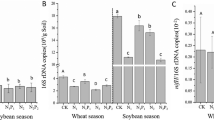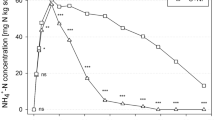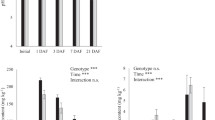Abstract
Exploitative fast-growing plants have higher demands for nutrients compared to conservative slow-growing plants. We presume that these differences in nutrient uptake highly influence the microbial performance mainly in the rhizosphere of nutrient-poor soils. In order to investigate the influence of plants with contrasting exploitation types on microbial communities at the root–soil interface, we performed a greenhouse experiment in a N-poor, sandy soil using the fast-growing plant Dactylis glomerata and the conservative, slow-growing plant Festuca rubra. We applied four different amounts of the inorganic fertilizer ammonium nitrate (0, 50, 100, and 200 kg NH4NO3 ha−1). After 6 weeks, the abundance of nitrifiers and denitrifiers was investigated in the root–rhizosphere complex (RRC) based on the quantification of the marker genes amoA, nirK, nirS, and nosZ. Furthermore, soil chemical properties and the plant biomass were determined. Independent from the investigated plant species, fertilizer applications up to 100 kg ha−1 resulted in a clear depletion of ammonium and nitrate in the RRC, with ammonium and nitrate concentrations <1 mg kg−1 dry weight (dw). Only the highest fertilizer rate increased both ammonium and nitrate concentrations in the RRC of both plants reaching concentrations of 9.5 mg kg−1 dw for ammonium and 92.5 mg kg−1 dw for nitrate. The abundance of bacterial ammonia oxidizers (AOB) followed this trend (increase in abundance in response to the highest fertilizer rate), and copy numbers up to 3.2 × 107 copies g−1 dw were measured in the RRC of treatments with F. rubra where 200 kg N ha−1 was applied. As the archaeal ammonia oxidizers (AOA) did respond neither to plant species nor to the fertilizer application, the AOA/AOB ratio decreased from 10 in the non-fertilized treatments to 2 in treatments with 200 kg N ha−1. Also the abundance of microbes involved in denitrification strongly increased in response to higher fertilization rates in the RRC of both plant species, although higher gene copy numbers were detected in the rhizosphere of D. glomerata mainly for nitrous oxide reducers (up to 2.7 × 108 copies g−1 dw). Surprisingly, the highest fertilization rates resulted in a 50 % decrease in abundance of microbes involved in nitrite as well as nitrous oxide reduction.

Similar content being viewed by others
References
Aerts R, Chapi FS (2000) The mineral nutrition of wild plants revisited: a re-evaluation of processes and pattern. Adv Ecol Res 30:1–67
Bannert A, Kleineidam K, Wiising L, Müller-Niggemann C, Vogelsang V, Welzel G, Cao C, Schloter M (2011) Changes in diversity and functional gene abundances of microbial communities involved in N fixation, nitrification and denitrification in a tidal wetland versus paddy soils cultivated for different time periods. Appl Environ Microbiol 77:6109–6116
Braker G, Fesefeldt A, Witzel KP (1998) Development of PCR primer systems for amplification of nitrite reductase genes (nirK and nirS) to detect denitrifying bacteria in environmental samples. Appl Environ Microbiol 64:3769–3775
Cesco S, Mimo T, Tonon G, Tomasi N, Pinton R, Terzano R, Neumann G, Weisskopf L, Renella G, Landi L, Nannipieri P (2012) Plant-borne flavonoids released into the rhizosphere: impact on soil bio-activities related to plant nutrition. Rev Biol Fertil Soils 48:123–149
Cocking E (2003) Endophytic colonization of plant roots by N-fixing bacteria. Plant Soil 252:169–175
Di HJ, Cameron KC, Shen JP, Winefield CS, O'Callaghan M, Bowatte S, He JZ (2009) Nitrification driven by bacteria and not archaea in nitrogen-rich grassland soils. Nat Geosci 2:621–624
Ellenberg H, Weber HE, Düll R, Wirth V, Werner W, Paulissen D (1991) Zeiggewerte von Pflanzen in Mitteleuropa. Scr Geobot 18:1–248
Fillery IP (2007) Plant-based manipulation of nitrification in soil: a new approach to managing N loss? Plant Soil 294:1–4
Fischer D, Ukas M, Tischler W, Kautz T, Köpke U, Schloter M (2013) Abundance of ammonia oxidizing microbes and denitrifiers in different soil horizons of an agricultural soil in relation to the cultivated crops. Biol Fertil Soils 49:1234–1246
Geisseler D, Horwath WR, Joergensen RG, Ludwig B (2010) Pathways of nitrogen utilization by soil microorganisms: a review. Soil Biol Biochem 42:2058–2067
Hai B, Diallo N, Sall S, Haesler F, Schauss K, Bonzi M, Assigbetse K, Chotte J, Munch J, Schloter M (2009) Quantification of key genes steering the microbial nitrogen cycle in the rhizosphere of sorghum cultivars in tropical agroecosystems. Appl Environ Microbiol 75:4993–5000
Henry S, Baudoin E, López-Gutiérrez JC, Martin-Laurent F, Brauman A, Philippot L (2004) Quantification of denitrifying bacteria in soils by nirK gene targeted real-time PCR. J Microbiol Meth 59:327–335
Henry S, Bru D, Stres B, Hallet S, Philippot L (2006) Quantitative detection of the nosZ gene, encoding nitrous oxide reductase, and comparison of the abundances of 16S rRNA, narG, nirK, and nosZ genes in soils. Appl Environ Microbiol 72:5181–5189
Kaye JP, Hart SC (1997) Competition for nitrogen between plants and soil microorganisms. Trends Ecol Evol 12:139–143
Lambers H, Poorter H (1992) Inherent variation in growth-rate between higher plants—a search for physiological causes and ecological consequences. Adv Ecol Res 23:187–261
Leininger S, Urich T, Schloter M, Schwark L, Qi J, Nicol GW, Prosser JI, Schuster SC, Schleper C (2006) Archaea predominate among ammonia-oxidizing prokaryotes in soils. Nature 442:806–809
Michotey V, Mejean V, Bonin P (2000) Comparison of methods for quantification of cytochrome cd1-denitrifying bacteria in environmental marine samples. Appl Environ Microbiol 66:1564–1571
Morley N, Baggs EM, Dörsch P, Bakken L (2008) Production of NO, N2O and N2 by extracted soil bacteria, regulation by NO2 − and O2 concentrations. FEMS Microbiol Ecol 65:102–112
Mrkonjic FM, Engel M, Hagn A, Munch JC, Sommer M, Schloter M (2009) Changes of diversity pattern of proteolytic bacteria over time and space in an agricultural soil. Microb Ecol 57:391–401
Müller C, Laughlin RJ, Spott O, Rütting T (2014) Quantification of N2O emission pathways via a 15 N tracing model. Soil Biol Biochem 72:44–54
Ollivier J, Töwe S, Bannert A, Hai B, Kastl EM, Meyer A, Su MX, Kleineidam K, Schloter M (2011) Nitrogen turnover in soil and global change. FEMS Microbiol Ecol 78:3–16
Palacios O, Bashan Y, de-Bashan LE (2014) Proven and potential involvement of vitamins in interactions of plants with plant growth-promoting bacteria—an overview. Biol Fertil Soils. doi:10.1007/s00374-013-0894-3
Peoples M, Craswell E (1992) Biological nitrogen fixation: investments, expectations and actual contributions to agriculture. Plant Soil 141:13–39
Personeni E, Löscher A, Loiseau P (2005) Rhizosphere activity, grass species and N availability effects on the soil C and N cycles. Soil Biol Biochem 37:819–827
Prinčič A, Mahne I, Megušar F, Paul EA, Tiedje JM (1998) Effects of pH and oxygen and ammonium concentrations on the community structure of nitrifying bacteria from wastewater. Appl Environ Microbiol 64:3584–3590
Reich PB, Wright IJ, Cavender-Bares JM, Craine JM, Oleksyn J, Wetoby M, Wallers MB (2003) The evolution of plant functional variations: traits, spectra and strategies. Int J Plant Sci 164:S143–S164
Robinson D, Prison IH (1988) Plasticity in grass species in relation to nitrogen supply. Funct Ecol 2:249–258
Rotthauwe JH, Witzel K, Lisack W (1997) The ammonia monooxygenase structural gene amoA as a functional marker: molecular fine-scale analysis of natural ammonia-oxidizing populations. Appl Environ Microbiol 63:4704–4712
Rütting T, Boeckx P, Müller C, Klemedtsson L (2011) Assessment of the importance of dissimilatory nitrate reduction to ammonium for the terrestrial nitrogen cycle. Biogeosciences 8:1779–1791
Schauss K, Focks A, Leininger S, Kotzerke A, Heuer H, Thiele-Bruhn S, Sharma S, Wilke BM, Matthies M, Smalla K, Munch JC, Amelung W, Kaupenjohann M, Schleper C, Schloter M (2009) Dynamics and functional relevance of ammonia-oxidizing archaea in two agricultural soils. Environ Microbiol 11:446–456
Subbarao GV, Ishikawa T, Ito O, Nakahara K, Wang HY, Berry WL (2006) A bioluminescence assay to detect nitrification inhibitors released from plant roots: a case study with Brachiaria humidicola. Plant Soil 288:101–112
Subbara GV, Rondon M, Ito O, Ishikawa T, Rao IM, Nakahara K, Lascano C, Berry WL, Subbara GV, Rondon M, Ito O, Ishikawa T, Rao IM, Nakahara K, Lascano C, Berry WL (2007) Biological nitrification inhibition (BNI)—is it a widespread phenomenon? Plant Soil 294:5–18
Tian XF, Hu HW, Ding Q, Song MH, Xu XL, Zheng Y, Guo LD (2014) Influence of nitrogen fertilization on soil ammonia oxidizer and denitrifier abundance, microbial biomass, and enzyme activities in an alpine meadow. Biol Fertil Soils 50:703–713
Töwe S, Albert A, Kleineidam K, Brankatschk R, Dümig A, Welzl G, Munch J, Zeyer J, Schloter M (2010) Abundance of microbes involved in nitrogen transformation in the rhizosphere of Leucanthemopsis alpina (L.) heywood grown in soils from different sites of the damma glacier forefield. Microb Ecol 60:762–770
Throbäck IN, Enwall K, Jarvis Å, Hallin S (2004) Reassessing PCR primers targeting nirS, nirK and nosZ genes for community surveys of denitrifying bacteria with DGGE. FEMS Microbiol Ecol 49:401–417
Verhoeven JTA, Koerselman W, Meuleman AFM (1996) Nitrogen- or phosphorus-limited growth in herbaceous, wet vegetation: relations with atmospheric inputs and management regimes. Trends Ecol Evol 11:494–497
Wallenstein MD, Myrold DD, Firestone M, Voytek M (2006) Environmental controls on denitrifying communities and denitrification rates: insights from molecular methods. Ecol Appl 16:2143–2152
Acknowledgments
This study was conducted as part of the ERA-Net BiodivERsA project VITAL, ANR-08-BDVA-008. We would like to thank the BMBF for funding and Gudrun Hufnagel for measuring the NH4 +-N, NO2 −-N, and NO3 −-N concentrations in the soil samples. For the experimental setup, the help of Dr. Sandra Lavorel is appreciated.
Author information
Authors and Affiliations
Corresponding author
Rights and permissions
About this article
Cite this article
Kastl, EM., Schloter-Hai, B., Buegger, F. et al. Impact of fertilization on the abundance of nitrifiers and denitrifiers at the root–soil interface of plants with different uptake strategies for nitrogen. Biol Fertil Soils 51, 57–64 (2015). https://doi.org/10.1007/s00374-014-0948-1
Received:
Revised:
Accepted:
Published:
Issue Date:
DOI: https://doi.org/10.1007/s00374-014-0948-1




